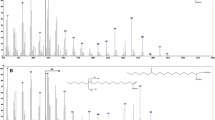Abstract
The major phospholipids of the psychrophilic bacteriumMicrococcus cryophilus, phosphatidylethanolamine and phosphatidylglycerol, have similar fatty acid compositions, comprising almost entirely palmitoleic and oleic acids. We show that there is a preference for the longer chains in thesn-1 position of both phosphatidylethanolamine and phosphatidylglycerol, both during isothermal growth and after temperature shifts, despite the fact that the overall phospholipid C18/C16 acyl chain ratio decreases with a lowering of growth temperature. Although it has been shown using model systems that the isomeric configurationsn-1-long,sn-2-short lowers lipid melting temperature, this paper reports the first clear-cut demonstration of such an isomeric preference in a natural system. We discuss how this acyl chain configuration contributes to membrane fluidity inM. cryophilus, in terms of adaptation to its psychrophilic habitat.
Similar content being viewed by others
Literature Cited
Baldassare, J. J., Rhinehart, K. B., Silbert, D. F. 1976. Modification of membrane lipid: physical properties in relation to fatty acid structure. Biochemistry15:2986–2994.
Baldassare, J. J., Brenckle, G. M., Hoffman, M., Silbert, D. F. 1977. Modification of membrane lipid: functional properties of membrane lipid in relation to fatty acid structure. Journal of Biological Chemistry252:8797–8803.
Bartlett, G. R. 1959. Phosphorus assay in column chromatography. Journal of Biological Chemistry234:466–468.
Christie, W. W. 1973. Lipid analysis. Isolation, separation, identification and structural analysis of lipids. Oxford: Pergamon.
Davis, P. J., Fleming, B. D., Coolbear, K. P., Keough, K. M. W. 1981. Gel to liquid-crystalline transition temperatures of water dispersions of two pairs of positional isomers of unsaturated mixed-acid phosphatidylcholines. Biochemistry20:3633–3636.
Dickens, B. F., Thompson, Jr., G. A. 1982. Phospholipid molecular species alterations in microsomal membranes as an initial key step during cellular acclimation to low temperature. Biochemistry21:3604–3611.
Foot, M., Jeffcoat, R., Barratt, M. D., Russell, N. J. 1983. The effect of growth temperature on the membrane lipid environment of the psychrophilic bacteriumMicrococcus cryophilus. Archives of Biochemistry and Biophysics224:718–727.
Goldfine, H. 1972. Comparative aspects of bacterial lipids. Advances in Microbial Physiology8:1–58.
Herbert, R. A. 1981. Low temperature adaptation in bacteria, pp. 41–53. In: Morris, G. J., Clarke, A. (eds.), Effects of low temperatures on biological membranes. London: Academic.
Keough, K. M. W., Davis, P. J. 1979. Gel to liquid-crystalline phase transitions in water dispersions of saturated mixed-acid phosphatidylcholines. Biochemistry18:1453–1459.
Melchior, D. L. 1982. Lipid phase transitions and regulation of membrane fluidity in prokaryotes. Current Topics in Membranes and Transport17:263–316.
Nishihara, M., Ishinaga, M., Kato, M., Kito, M. 1976. Temperature-sensitive formation of the phospholipid molecular species inEscherichia coli membranes. Biochimica et Biophysica Acta431:54–61.
Raetz, C. R. H. 1978. Enzymology, genetics and regulation of membrane phospholipid synthesis inEscherichia coli. Microbiological Reviews42:614–659.
Russell, N. J. 1971. Alteration in fatty acid chain length inMicrococcus cryophilus grown at different temperatures. Biochimica et Biophysica Acta231:254–256.
Russell, N. J. 1974. The lipid composition of the psychrophilic bacteriumMicrococcus cryophilus. Journal of General Microbiology80:217–225.
Russell, N. J. 1983. Adaptation to temperature in bacterial membranes. Biochemical Society (UK) Transactions11:333–335.
Russell, N. J. 1983. The regulation of membrane fluidity in bacteria by acyl chain length changes. Biomembranes, in press.
Russell, N. J., Sandercock, S. P. 1980. The regulation of bacterial membrane fluidity by modification of phospholipid fatty acyl chain length, pp. 181–190. In: Kates, M., Kuksis, A. (eds.), Membrane fluidity: biophysical techniques and cellular regulation. Clifton, NJ: Humana.
Russell, N. J., Volkman, J. K. 1980. The effect of growth temperature on wax ester composition in the psychrophilic bacteriumMicrococcus cryophilus ATCC 15174. Journal of General Microbiology118:131–141.
Sandercock, S. P., Russell, N. J. 1980. The elongation of exogenous fatty acids and the control of phospholipid acyl chain length inMicrococcus cryophilus. Biochemical Journal188:585–592.
Seelig, J., Seelig, A. 1980. Lipid conformation in model membranes and biological membranes. Quarterly Reviews of Biophysics13:19–61.
Author information
Authors and Affiliations
Rights and permissions
About this article
Cite this article
McGibbon, L., Russell, N.J. Fatty acid positional distribution in phospholipids of a psychrophilic bacterium during changes in growth temperature. Current Microbiology 9, 241–244 (1983). https://doi.org/10.1007/BF01567194
Issue Date:
DOI: https://doi.org/10.1007/BF01567194




